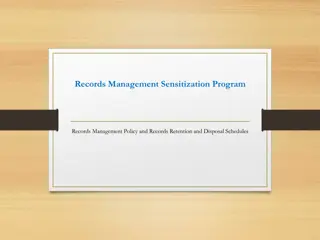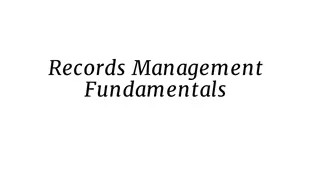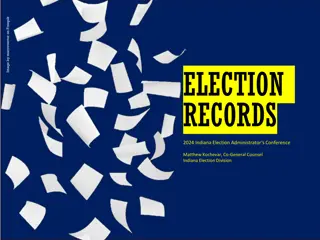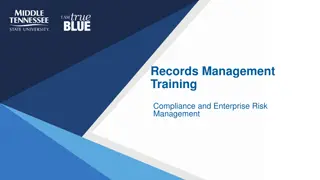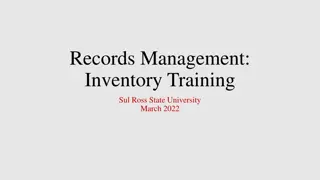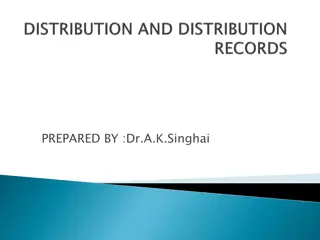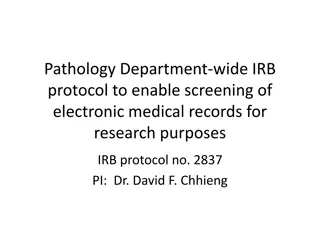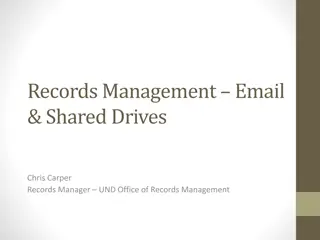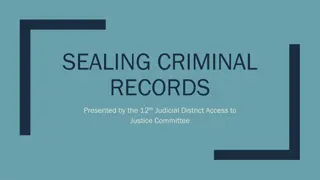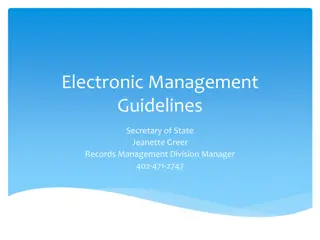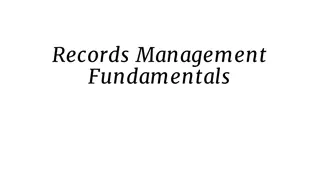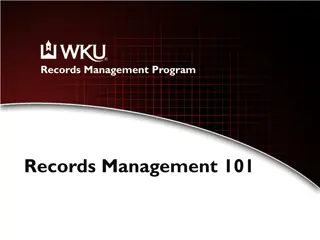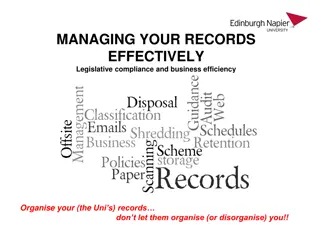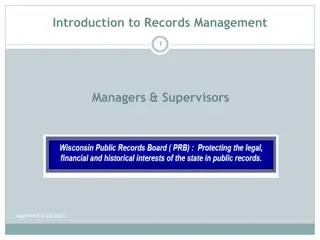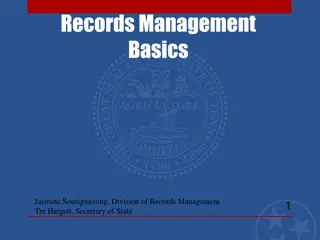Efficient Records Management Practices and Procedures
Learn about Records Disposition Authorizations, Statewide RDA, Specific RDA, Retention Schedules, and the Benefits of a Retention Schedule in ensuring compliance with laws, protecting records, and reducing costs. Discover the steps to create, revise, or delete an RDA via the web app provided.
Download Presentation

Please find below an Image/Link to download the presentation.
The content on the website is provided AS IS for your information and personal use only. It may not be sold, licensed, or shared on other websites without obtaining consent from the author.If you encounter any issues during the download, it is possible that the publisher has removed the file from their server.
You are allowed to download the files provided on this website for personal or commercial use, subject to the condition that they are used lawfully. All files are the property of their respective owners.
The content on the website is provided AS IS for your information and personal use only. It may not be sold, licensed, or shared on other websites without obtaining consent from the author.
E N D
Presentation Transcript
RDA Development JASMINE SOURIGNAVONG, RECORDS MANAGEMENT DIVISION TRE HARGETT, SECRETARY OF STATE,
Records Disposition Authorizations Records schedules are implemented through the establishment of Records Disposition Authorizations (RDA) which provide the following information: Description of records grouped by common function or record series. The length of time the records series must be kept. Any legal restriction of access. The required method of destruction.
Statewide RDA BEFORE CREATING A NEW RDA, IT IS IMPORTANT TO MAKE SURE THE RECORD IS NOT ALREADY COVERED UNDER A STATEWIDE RDA STATEWIDE RDA S DOCUMENT RECORDS THAT STATE AGENCIES HAVE IN COMMON, SUCH AS FISCAL, ADMINISTRATIVE, PERSONNEL, ETC.
Specific RDA Before Creating a new RDA, it is important to make sure the record does not already have an RDA. This applies to records that are unique to a state agency s operations and mission. The schedules identify records that the agency produces, collects, receives, or retains in carrying out its special functions. Examples Surveys Grants Case Files Audits
Retention Schedule Establishing a retention schedule requires appraising the use and value of information, as well as researching regulations that may govern retention Retention schedules are not merely suggestions. Records cannot be destroyed before the stated period, nor should they be retained longer than the stated period unless they are involved in : An investigation Litigation Audit Request for records pursuant to the Freedom of Information Act
Benefits of a Retention Schedule Benefits of a Retention Schedule Ensures that an agency or department is in compliance with both state and federal laws. Verifies that records with legal, fiscal, or administrative purposes are not destroyed prematurely. Determines when records may be transferred to State Records Center or other location for permanent storage. Details essential records protection plan. Ensures the preservation of historical records Indicates the privacy status of a records series. Reduces cost by: Allowing records that are no longer useful to be legally destroyed. Reduce the space and equipment necessary for filing records in paper or electronic format.
Web App BEFORE YOU START CREATING, REVISING, OR DELETING AN RDA: CONTACT YOUR RECORDS OFFICER OBTAIN A LOG IN AND PASSWORD VISIT HTTP://WWW.TNSOS.NET/RMD/RDA AND LOG IN TO THE SITE AND CLICK REQUEST NEW RDA
Core Data Record Series Title Determine a unique, specific, descriptive title for the record series. Titles should clearly identify the subject and/or functions of the records. Please spell out any acronyms. Records Series Abstract Describe the purpose of the records series, indicating: What documents are included in the records series. Any specific details that may be helpful such as form number. Records Series Active Indicate whether the records series is still in use- in other words, whether more files of this type are being generated.
File Cutoff File Cutoff The file cutoff date is a break or stop in the filing of a current records series, based on a predetermined event. In a Record series that is active, this is when a new file is created for the records of the same type. The file cutoff date keeps related documents together. The Web Application provides the two most common choices: Fiscal Year Calendar Year Select other and provide and explanation if Files follow a different timeframe, such as: Federal Fiscal year Academic year The close of a case The end of a grant or program
Retention Total Retention The total amount of time your agency is responsible for the retaining the record series- from file cutoff to final disposition. This includes any time the records may be held at the State Records Center. For example: Records that are kept in agency for 10 years and then transferred to Richards and Richards for 10 years would equal 20 years total retention. Retention End Action Options: permanent or destroy. Records that are transferred to TSLA are classified as Permanent records
Disposition Notes Disposition notes: Provide a description of the life of the particular records series. Include the following: Explain how the record is received or generated. Identify the event that triggers the retention countdown. Describe any reformatting (paper, electronic, etc.) Detail where the record is stored and if/when it is transferred State the retention Describe the final disposition of the record series Describe any work processes that make the requested retention necessary. For Example: Files are cut off when the employee terminates, maintained for ten years. Records may be maintained in either paper or electronic format, as long as the electronic content has been verified for completeness, accuracy, and usability. Records in Paper format may be transferred to the State Records Center. Records in electronic format shall be maintained in Office of Information Resources (OIR) approved software and server environment. Any sensitive or confidential information contained therein shall be destroyed according to standards for destruction of confidential information.
Worksheet The Worksheet portion of the RDA describes how files will be arranged, categorized, accessed, and stored, whether in paper or electronic format. This information reflects good filing practices and ensures the right file can be retrieved quickly for the lowest possible cost.
File Arrangement Describes how files are organized. The most common methods of arranging documents are alphabetical, numerical, chronological, or alphanumeric. Sometimes it will be arranged by case number or grant number.
Media Format Generated and Media Format Stored A particular record series may include multiple formats such as paper, electronic, or microfilm. This information is useful for TSLA in their appraisal of the records value. Provide information about the record format in all stages of its life: how it is received, stored, and if applicable, archived.
Date Range, Annual Accumulation, Current Volume Date Range Provide the range of years of accumulated records covered by this RDA. Annual Accumulation Provide an estimate of the volume of records created, received, and retained in the course of a year for the series in questions. Current Volume Provide an estimate of the total volume of records covered by this RDA, from the earliest to the most recent, in all storage location.
Record Value Historical Value: Only a small percentage of records have permanent value, but these records are especially important since they document our state s history; contains important information about persons, places, or events; or are valuable because of age or rarity. The Tennessee State Library and Archives determines the Historical Value of records desired for permanent retention. For example; A lease signed by Andrew Jackson, Historical and Architectural Records.
Administrative Value Administrative Value: These records are necessary for day-to-day operations, to conduct current or future business transactions, or to document the establishment of policy or programs. Some examples include correspondence, studies, and reports.
Legal Value Legal Value: These records have a mandated retention by statute or regulation. The Division of Records Management request assistance from the Office of General Counsel in order to determine the legal value of records. Examples of these documents include leases deeds, student records, medical records, and court case files.
Fiscal Value Fiscal Value: These Records document the fiscal responsibilities and transactions of an agency or department, such as receipt, payment, transfer, adjustment, or encumbrance of public funds. Most financial records usually lose value once an audit has been completed. However, certain records series may be governed by regulations beyond audit, such as federal regulations or contract language. Examples include, cancelled checks, deposit slips, invoices, receipts, and purchase orders.
Audit Requirements Audit Requirements In order to ensure an effective government for the citizens of Tennessee, all records are subject to audit by the Comptroller s Office Please indicate whether or not the records series is subject to Federal Audit and use the space provided to list the interested agencies.
Reference Frequency and Data Update Frequency Reference Frequency Indicate the average number of references to the record series per month. Data Update Frequency Indicate how often the data is updated applies to electronic records only.
Information Shared Outside of the State Indicate if the record series is shared with federal agencies or agencies of other states. If yes please list the agencies.
Essential Record Essential records contain information required by an agency to function or to reestablish operations immediately in the event of a disaster. Without these records, public interest could be adversely affected by unplanned expenditures, lost revenue, lost information and efficiency, and disruption of operation. While some records have historical value, they may not be administratively necessary to keep an agency running or to provide to citizens. The main protection methods for essential records are duplication and off-site storage. Duplication entails photocopying, scanning, or microfilming. It is strongly recommended that duplicates be stored offsite while still being accessible in the event of a disaster.
Confidentiality Indicate whether any state or federal regulations restrict access to the records Records that are deemed confidential must be covered by statute and a copy of the statute must be attached
Media Recommendation Media Recommendation This is the agency s preferred/recommended format in which the records are/will be kept: Current Format (most common) Microfilm Microfiche Other
Retention Agency Retention is the total time the records are kept in agency. Agency Retention Active and Inactive should equal the Agency Retention. Records Center Retention Period is the total time records are kept at the records center. Agency Retention and the Records Center Retention should equal the Total Retention located in the core data For Example: If records are kept in agency for 1o years and then sent over to Richards and Richards for 20 years the total retention is 30 years.
Final Disposition Indicate action that is to occur after retention period expires. If it is not to be destroyed, it will either be transferred to State Library and Archives, Microfilmed, or Migrate to Electronic Data (if records are kept in agency permanently.)
Legal Citation Indicate if the record series is covered by statute or rule: Tennessee Code Annotated (TCA) Code of Federal Regulations (CFR) Environmental Protection Agency (EPA), etc Cite any authority governing creation, management, retention, and/or disposition of series Note any agency, state, or federal law, regulation, or policy.
Uploads Legal Citation Upload Records Sample Upload The sample should be representative of the record series. Be sure to redact any protected information that may be in the sample. Any statute covering: Retention Confidentiality If the record series is governed by multiple citations, please combine them into a single PDF and attached in the application.
System Name IT- ABC Number Hardware Description Software Description System Location Backup Procedures Disaster Recovery Data Migration Description Metadata Description Electronic Records Plan Inventory If the records are maintained electronically, this section must be fully completed. It is recommended that you get the information for this entire section of the RDA from someone in the agency s IT office. The entire Electronic Records Plan Inventory must be completed
What Happens Now? After the RDA is completed and submitted it will go through a review process. It will be reviewed by the Records Management Division, TSLA, and Audit. Once reviewed the agency may respond to any recommendations. The completed RDA then goes before the PRC. Once the PRC approves the RDA will then become effective.
Why do you need all of this Information? Although the RDA asks for a significant amount of information about the record series, the PRC nevertheless requires that the information be provided on the RDA. This process is, ultimately, required by law and this effort flows from the PRC s resolution to ensure our state is complying with Tenn. Code Ann. 10-7- 303 (d) and 10-7-509 (a).
Remember Records are not to be destroyed without an RDA according to T.C.A. 10-7-303 Destruction Procedures. No record or records shall be scheduled for destruction without the unanimous approval of the voting members of the Public Records Commission. Approval for the destruction scheduling from the Commission is received through the RDA process. All agencies shall destroy records using state approved procedures. Records Management is available to assist you by advising on the development, utilization, retention, disposition, and destruction of records. If you have any questions please contact me at: 615-253-4572, or; Jasmine.sourignavong@tn.gov






